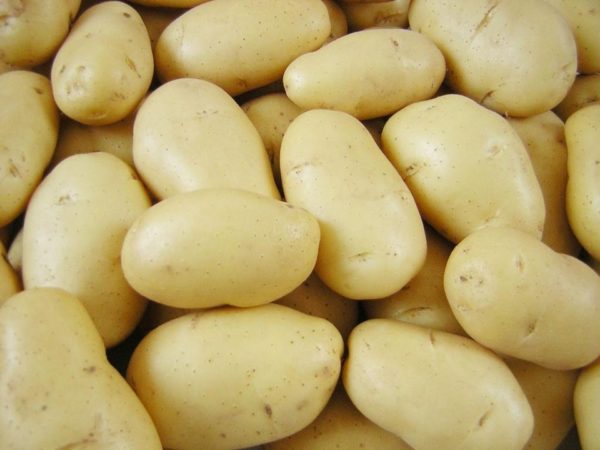
Description of the Queen Anna potato variety, reviews and characteristics, all testify to the high demand and positive qualities of the vegetable. Therefore, it is grown not only by farmers, but also gardeners and summer residents on their private lands.
According to the description, Queen Anne potatoes are classified as a precocious variety. It is believed that for the full ripening of the vegetable takes about 70 days. But tubers are allowed to eat a little earlier, they will simply have a thin peel that easily lags behind potatoes.
The bush of the plant reaches medium height, the stems are straight with large bright green leaves. Their shape and bushiness of potatoes is largely determined by the sufficient content of organic substances in the soil, as well as nitrogen.
During the flowering period, flowers form on the plant, which are characterized by a large size with a whitish hue. When the tubers are sufficiently formed, the flowers fall off, the leaves may dry out and turn yellow. This indicates the end of maturity and the need for harvesting.
The period of full vegetation of the vegetable is approximately 70 days, so this variety is classified as early. As for pests and diseases, the plant has good resistance to one and the other, is determined by a rich harvest and is not particularly whimsical to the choice of soil.
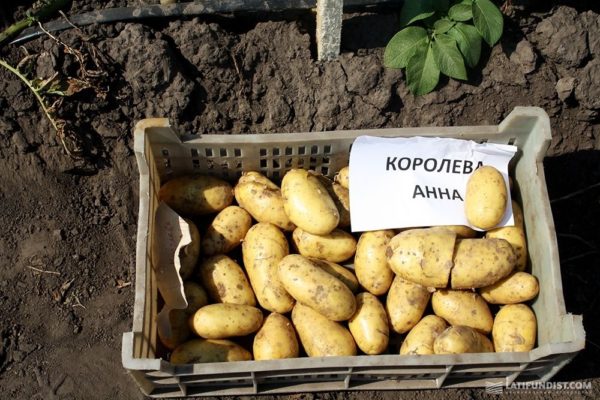
A complete description of the Queen Anna potato variety is as follows:
- Tubers are medium in size, reaching a weight of 90 g or more.
- A high starch content of 14% is noted.
- Potatoes are suitable for long-term storage and have good marketability.
- Vegetable cultivation is carried out on any soil.
- Tubers are well boiled, used to prepare various dishes and do not darken during cooking.
- Excellent taste.
- Potatoes are not very whimsical to care for.
Content
Characteristics of the root crop
Queen Anna potato tubers have this characteristic:
- The shape prevails round and slightly elongated with the presence of small, neat little eyes. The peel is thin and delicate, easy to clean.
- The flesh of the potato is of a rich yellow hue, therefore it is moderately and quickly boiled and suitable for different dishes.
- The tubers look smooth, rarely formless. Their weight averages 80 g, but they also occur in 140 g.
- The taste qualities of the tubers are excellent, a sweetish taste is noted, but according to the reviews of gardeners and gardeners, the taste of the vegetable depends on the external environment, so it is important to maintain optimal weather conditions. If there is no rain, carry out watering when heavy rains, more often loosen and weed the ground.
- The starch content in potatoes ranges from 13 to 15%, so the vegetable is widely used for food production of starch and other products.
- When cooking tubers do not boil, which allows the use of potatoes for salads, soup and home-made chips. Fried potatoes from the Queen Anna variety are also good.
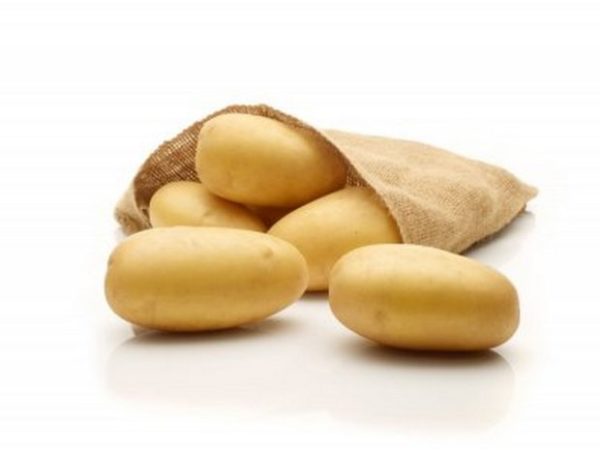
Productivity
Based on the description, photos and reviews of the Queen Anna potato variety, we can conclude that the vegetable has a high yield, which can be achieved as a result of 2 months of cultivation.But, and if climatic conditions allow, planting can be carried out twice a year, then the yield will be 2 times greater, which is especially good for farmers or private traders who sell potatoes for sale.
Based on statistical data, it is possible to trace the following pattern in the crop: on the 45th day from the moment of planting potatoes, its amount is up to 140 kg / ha. On day 55, up to 220 kg / ha, and the maximum yield with technical maturity can be obtained from 300 to 500 kg / ha, depending on the growing technology and compliance with the rules of care.
Escape Description
Potato Queen Anna has an erect shoot, moderate bushiness. The height reaches an average value, the stems are not much set apart. There are many leaves, they are large, slightly wrinkled with pronounced veins and a saturated green color.
There are quite a few flowers on the bush, they are of medium size with a whitish color and small petals. Seeds and berries are rarely formed.
Climatic growing zones
Due to its early technical maturity, Queen Anne potatoes can be grown in any part of Russia. Europe is also acceptable. In areas where aridity predominates, a good harvest can also be obtained, it is only necessary to conduct thorough watering.
Advantages and disadvantages of the variety
Based on the reviews of gardeners and gardeners, we can conclude that the Queen Anna potato is characterized by minimal flaws and has many advantages.
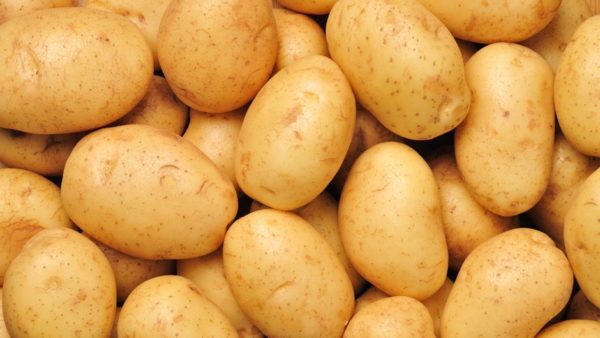
Among the negative qualities, low resistance to aridity, damage to bushes by single diseases and exactingness to moisture in arid areas are distinguished.
The benefits of potatoes are:
- High yield.
- Good taste and content in the tuber of vitamins, nutrients.
- Suitability for marketability and long shelf life.
- Fast maturity of potatoes.
- Resistant to mechanical stress.
- Not fastidious in growing and does not need a special type of soil.
- It is immune to pests and certain diseases.
Growing rules
Planting potatoes Queen Anna is held in the traditional manner, as for other varieties. There is no particular difficulty in growing a vegetable, the main thing is to observe the care, to know in which area you can plant a plant and how to fertilize the soil. The only difference between this type of potato is that it requires more moisture in arid areas and tubers should only be planted in warm, moist soil.
Landing place
When growing potatoes of the Queen Anne variety, you need to choose the right land. It is not recommended to plant the plant in the place where nightshade crops were last summer. After them, planting is allowed only after 3 years, since such vegetables have special properties and take away all useful substances from the soil.
Also, you can’t grow potatoes every year on one site so that the tubers do not degenerate.
Queen Anne's potato predecessors may be cucumbers, beans, or cabbage. Also, when planting a vegetable, one should take into account the illumination of the territory, the location of groundwater, soil moisture and climatic conditions.
Soil requirements
For the best cultivation of potatoes and a rich harvest, it is better to choose black soil, loamy or sandy loam soils. The soil should be loose, with good breathability and chemical content.
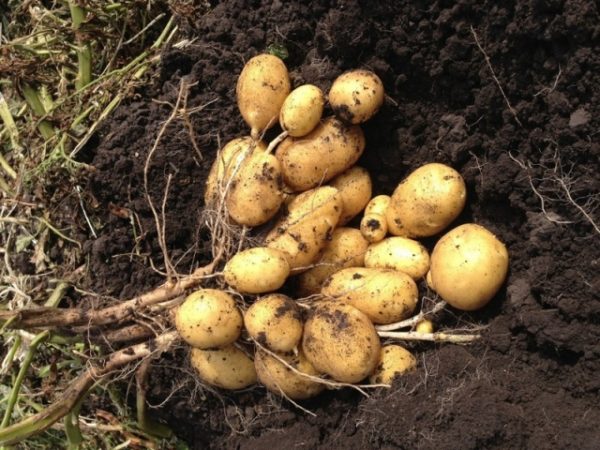
To increase the fertility of the earth, use various top dressings. For example: wood ash, humus, magnesium substrate and other means are also used. The acidity of the soil when planting potatoes should be no more than 6.A higher indicator is not suitable for a vegetable, because the plant has poor contact with an acidic and alkaline environment, and weeds will constantly grow on this site.
Rules for planting potatoes Queen Anne
Queen Anne earned great popularity for its ease of cultivation and rich harvest. According to reviews of gardeners and summer residents, even a slight care will be sufficient for a good yield of this vegetable.
Optimal timing
Choosing a planting date is very important for potatoes. Since overly early planting will not bear fruit, the tubers can sit in the ground for a long time and not germinate. Therefore, it is important to know the exact time when you can grow potatoes.
It is believed that for the Queen Anne variety, the optimal time is the 20th of April to May 15th. You can also navigate through the trees. Some gardeners and gardeners begin planting vegetables when the leaves bloom near the birch.
With regard to temperature, the best time for potatoes appears to be hot weather, slightly moist soil, which is warmed up to at least 10 cm in depth.
Preparing planting material
In order for the potatoes to sprout together and bring a rich harvest, planting material should be prepared in advance. About a week before the expected day of planting, you need to check the potatoes and select the best tubers, excluding spoiled, mice and too small root crops.
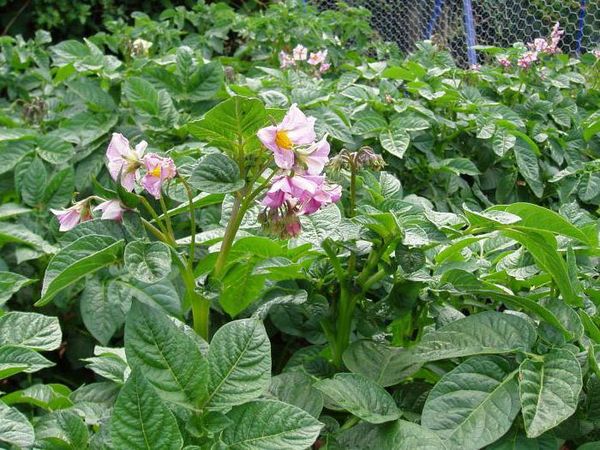
The selected seed material is placed in bags and exposed to the street, where there is enough sunlight. The latter is necessary for drying the tubers and their germination, so that further shoots appear simultaneously.
Landing pattern
Planting Queen Anne potatoes is quite easy, you just need to adhere to the general rules in growing:
- Since autumn, the soil is recommended to be prepared in advance. To do this, dig up the soil, scatter compost or manure and again dig it up. In spring, nitrogen compounds can also be added.
- Potatoes are being planted in the prepared ground. At this point, it is important to observe the interval. Between the bushes leave 40 cm, and between the rows of 70 cm and dig small holes.
- In the resulting holes put the tubers sprouts up and not tightly bury.
- It is desirable to place peat on top of the holes, so germination will improve and the soil will be enriched with substances.
Care Rules
Rich potato yields can only be achieved through good plant care. Despite the fact that the vegetable of this variety is not whimsical, you still need to carry out basic methods of care:
- When the tubers begin to form, it is important to water abundantly and regularly. This occurs during flowering bushes. The frequency of watering is 1 time per week. After it, it is necessary to loosen the soil and weed.
- It is necessary to timely remove flowers on the plant, so that future tubers are large and mature faster.
- Since the root system of Queen Anne potatoes is located almost on the surface, bushes should be more often spudded. This procedure not only helps protect the roots, but also eliminates the drying out of the soil and the accumulation of excess fluid.
- For intensive growth of potatoes, it also needs to be fed. Fertilizer is applied, as a rule, 3 times during the entire growth of the vegetable - this is during the period of the development of the bush, when the flowering of flowers begins and at the active stage of flowering. Mineral and organic compounds are used as top dressing.
- It is important to weed potatoes in time to remove weeds, and to ensure breathability due to loosening the soil.
- Throughout the growth of potatoes, you should look at the bushes for pests and their diseases in order to take timely measures and preserve the crop.
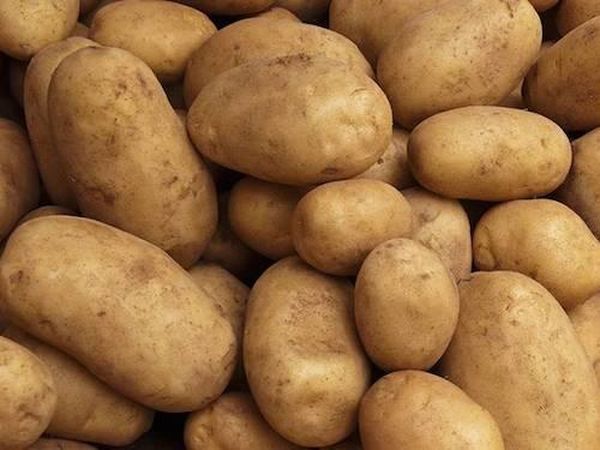
Diseases and Pests
If you do not follow the technology of cultivation and do not care for plants, potatoes can easily become infected with diseases and pests.
Among the diseases dangerous are rot, late blight, cancer, spotting, fungus, scab and others. All of them are characterized by a violation of the integrity of not only the leaves and stem, but also the tuber itself. Therefore, it is important to carry out prophylaxis, eliminate diseases on time and, in addition, timely fertilize the soil, water potatoes and spray with special preparations.
Common pests of Queen Anna potato are Colorado potato beetle, bear, wireworm. They affect the plant not only outside but also in the soil.
Harvesting and storage
Potatoes are harvested after 70 days from planting. You can also navigate by appearance - the leaves will dry out, the tops turn yellow, the flowers fall off.
Depending on the time of cultivation, the potato harvesting period may come at the beginning of July or August.
Storage of vegetables is carried out in the cellar, where the minimum temperature is at least 3C. Before storing vegetables, they should be dried and selected bad, spoiled tubers. After the potatoes are poured into bags and placed in a storage place.
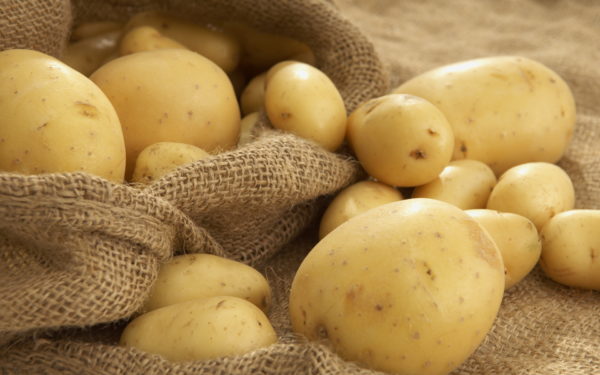
Reviews
Alina, 34 years old:
“About the potato of Variety Queen Anna, I can only say good things. I liked the simplicity of growing, the vegetable is very unpretentious, grows quickly, the taste is excellent and resistant to disease. "
Ivan, 29 years old:
“Last year, he planted several varieties of potatoes in the garden, including Queen Anne. Based on the crop, I concluded that I would only plant this variety. The tubers are medium-sized, smooth, non-digestible, stored for a long time. The vegetable is very resistant to disease and has good marketability. ”
Olesya, 37 years old:
“For a very long time I was looking for a suitable potato variety, because my soil is moist. My friend advised Queen Anna, whom she had been planting for 4 years. We harvest very pleased, the tubers are large, even, the flesh is yellow and with a light sweet taste. "I only ripened potatoes for 2 months, during which I huddled 2 times and half the garden.




 Description and description of varieties in Belarus with a photo
Description and description of varieties in Belarus with a photo Do I need to pick flowers from potatoes: why do they do it
Do I need to pick flowers from potatoes: why do they do it When to dig potatoes: timing and availability of new potatoes
When to dig potatoes: timing and availability of new potatoes How to grow a good potato crop: various methods and methods, planting and care
How to grow a good potato crop: various methods and methods, planting and care